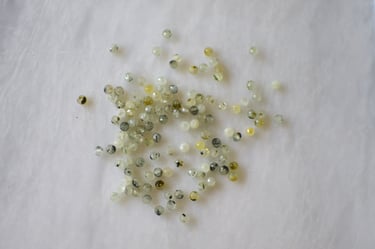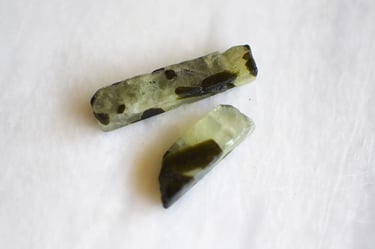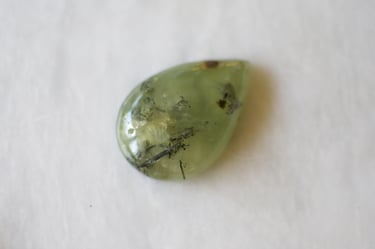Prehnite
Inner Peace, Prophetic Insight, Heart-Centred Healing, Emotional Release, Spiritual Preparedness
Metaphysical Properties:
Prehnite is known as a stone of unconditional love and deep emotional healing. It’s often described as a bridge between the heart and the will—helping one to act from the heart and align intention with compassion. This gentle yet powerful stone enhances intuition and is believed to stimulate prophetic visions, particularly in dreamwork and meditation. It encourages personal growth through calm reflection and is typically used to clear emotional debris or energetic clutter. Prehnite fosters peace, acceptance, and preparedness, making it ideal for those seeking to be spiritually and emotionally ready for life’s challenges.
Symbolism & Associations:
Prehnite is often called the “Healer’s Healer,” symbolising preparedness, serenity, and the harmony of mind and heart. It represents the balance between letting go and holding space.
Chakra Alignment:
Primarily connected to the Heart Chakra, Prehnite also activates the Solar Plexus Chakra, uniting emotional intelligence with personal power.
Planets:
Venus, Moon
Zodiacs:
Libra, Virgo
Elements:
Earth, Water
Similar Stones:
Green Aventurine, Serpentine, Chrysoprase, Jade, Moss Agate
Correspondences:
Colours: Soft green, yellow-green, mint, pale apple
Crystals: Moonstone, Green Calcite, Scolecite, Rose Quartz
Flowers: Apple blossom, Jasmine, Lily
Herbs: Lemon balm, Peppermint, Mugwort
Essential Oils: Neroli, Cypress, Rose, Bergamot
Incense: Myrrh, Gardenia, Green tea
Metals: Copper, Silver
Months, Days, & Seasons: September, Monday, Thursday, Spring, Early Summer
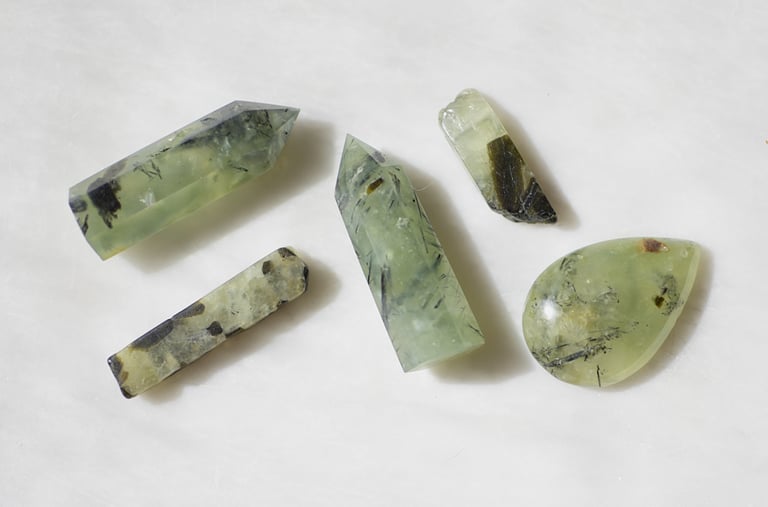

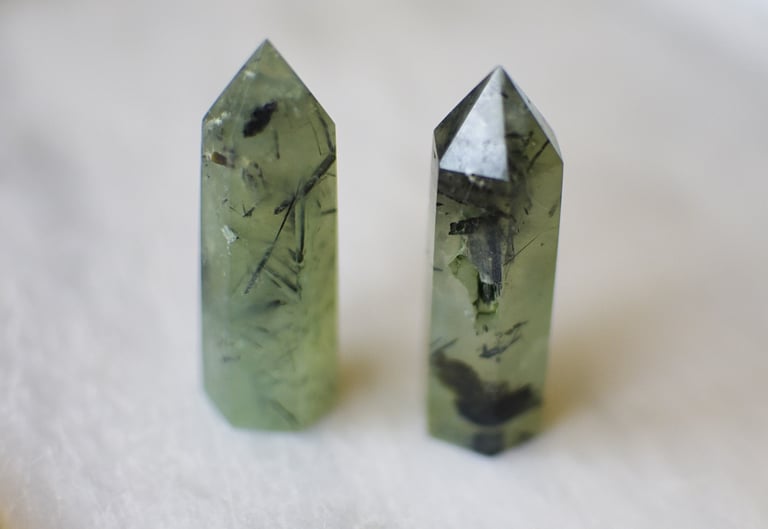

Facts
Stone Type:
Phyllosilicate – Calcium Aluminium Silicate
Hardness Rating:
6–6.5 on the Mohs scale – durable for jewellery but should be handled with care to avoid scratching or breakage.
Chemical Formula:
Ca₂Al(AlSi₃O₁₀)(OH)₂
Care Guide
Prehnite should be kept away from harsh chemicals and ultrasonic cleaners. Clean with lukewarm water and a soft cloth. While suitable for jewellery, rings or bracelets should be worn with care to prevent chipping.
Spiritual
Used for dream recall, divination, and heart-centred meditation. It is also commonly placed in healing spaces to enhance energy flow and create a calm, nurturing environment. Prehnite is often used to strengthen the energetic field and align spiritual practice with compassionate intention.
Healing
Prehnite supports the body’s natural healing processes, for the heart, lungs, and kidneys. It's thought to regulate blood flow, strengthen connective tissues, and boost immunity. Commonly used for detoxification, pain relief, and balancing subtle energies, it also helps relieve tension linked to emotional stress or energetic blockages.
Cleansing
Prehnite benefits from gentle cleansing methods. It responds well to sound (such as tuning forks or singing bowls), smoke from white sage or palo santo, and moonlight. Avoid prolonged exposure to direct sunlight, as its colour may fade over time.
Affirmations
“I act from the wisdom of my heart.”
“I am open to divine insight and inner knowing.”
“I release emotional clutter and make space for peace.”
“I am prepared for whatever comes with calm and clarity.”
Meditation
Prehnite is ideal for meditative journeys and visualisation practices that focus on healing the heart and enhancing inner vision. Visualising soft green light radiating from the heart while holding Prehnite can deepen feelings of peace and trust, can assist in uncovering emotional blockages and
Astrology
Associated with Virgo and Libra, Prehnite resonates with the desire to serve, heal, and maintain balance. Its connection to Venus and the Moon strengthens its emotional and intuitive energies, supporting harmonious relationships and self-reflection.
Vibration
Prehnite has a gentle, harmonious frequency that promotes a sense of inner balance and alignment. Its vibration is often described as subtle yet deep, creating a peaceful resonance that encourages clarity, emotional resolution, and spiritual readiness.
Did You Know:
Prehnite was the first mineral named after a person, Colonel Hendrik von Prehn, a Dutch mineralogist and military commander. It was also the first mineral ever described from South Africa, where it remains a significant source. Despite its soft, serene colour, Prehnite can sometimes exhibit chatoyancy (a cat’s eye effect) or appear slightly glowing in natural light due to its internal structure.
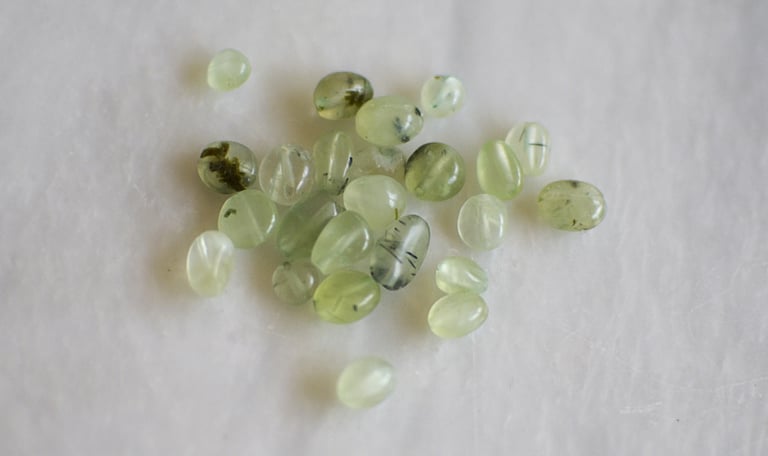

Mythology & Folklore
Though Prehnite does not feature prominently in the mythologies of ancient civilisations, it has gathered symbolic and energetic lore in modern metaphysical traditions and through cultural narratives passed down in oral histories. Often referred to as the "Stone of Prophecy" or the "Healer's Healer," Prehnite has become closely associated with spiritual attunement and divine communication.
Some metaphysical traditions suggest that Prehnite was used by Lemurian priestesses and seers to access higher planes of wisdom and record energetic knowledge. It is said to contain the vibrational memory of Earth’s ancient mysteries, particularly connected with the plant kingdom and elemental energies. According to these beliefs, Prehnite was treasured in past lives for its capacity to bridge the conscious mind with the dream state and was used during rites involving nature spirits and fae folk.
In South African spiritual folklore, where Prehnite was first discovered, it has been linked with ancestral wisdom and is said to form a protective barrier between the wearer and unwanted spiritual intrusion. Some stories suggest it was seen as a “guardian stone” for shamans and medicine keepers, guiding their healing work with unseen forces while shielding them from harm. Its gentle green hue, reminiscent of spring leaves and new growth, has made it a symbol of renewal and hope in various earth-based and animistic traditions.
Modern crystal workers often assign angelic qualities to Prehnite, associating it with Archangel Raphael—the healer—and claiming it enhances access to spiritual guidance. This link has formed a modern mythos around Prehnite, casting it as a stone of angelic resonance that soothes emotional pain while encouraging intuitive awakening. In the dream world, it is believed to promote lucid dreaming, protect from nightmares, and reveal hidden fears in a safe, compassionate way.
Although not bound to any single cultural myth, Prehnite has gathered its own metaphysical mythology in contemporary crystal lore. It is seen as a sacred ally for sensitives, empaths, and those walking the path of healing, peacekeeping, and spiritual stewardship of nature. The modern mystical community often views it as a “bridge between worlds,” allowing communion with both ancestral memory and the green wisdom of the Earth.
Historical Significance
Prehnite holds the honour of being the first mineral ever named after an individual, Colonel Hendrik von Prehn, a Dutch mineralogist and military commander stationed in South Africa during the 18th century. Discovered in the Karoo region of the Eastern Cape, the stone was officially recognised and classified in 1788. Von Prehn sent the stone to Europe for study, where it was analysed and added to mineralogical records. Its naming marked a new era in the scientific documentation of gemstones and helped to solidify South Africa’s place on the global mineralogical map.
During the 19th century, Prehnite gained popularity among European collectors for its attractive green tones and unique botryoidal (grape-like) formations. While it was not commonly used in jewellery during this time—due to its relative softness—it was prized as a specimen mineral in museum collections and private cabinets of curiosities. Mineralogists noted its peculiar habit of forming in conjunction with zeolites and other secondary minerals, particularly in basaltic lava flows and hydrothermal environments.
Though not a traditional gemstone in historical jewellery-making, Prehnite has more recently been adopted into modern jewellery design due to advances in lapidary techniques and its increasing popularity in metaphysical communities. Since the mid-20th century, it has gained widespread use in spiritual healing circles, largely fuelled by the New Age movement and the expansion of interest in crystal energy work.
In Australia and China, where large deposits of gem-quality Prehnite have been found, the stone has begun to feature more prominently in both fine and decorative jewellery. In recent decades, high-transparency Prehnite has become increasingly sought after for its glowing, ethereal quality. It has been featured in spiritual art, altar pieces, and energy tools such as wands, spheres, and palm stones.
Its historical significance has been further cemented by its role in eco-conscious and holistic lifestyles, where it is valued not just for aesthetic appeal but for its association with sustainability, gentle healing, and planetary awareness. As the metaphysical movement continues to evolve, Prehnite’s place in contemporary crystal history is firmly rooted in its reputation as a stone of peace, connection, and sacred service to both people and planet.
Origin & Formation
Prehnite is a calcium aluminium silicate mineral that commonly forms in hydrothermal environments, particularly within cavities of volcanic and igneous rocks such as basalt. Its formation occurs through the secondary mineralisation process, meaning it develops after the primary rock has already solidified. Prehnite is most often found in association with zeolites, quartz, epidote, calcite, and apophyllite, and it frequently lines the interiors of geodes and vesicles in lava flows.
The mineral forms under low-grade metamorphic conditions, typically in the prehnite-pumpellyite metamorphic facies—a specific temperature and pressure range associated with the alteration of basaltic rocks. In these environments, hydrothermal fluids rich in calcium, aluminium, and silica slowly precipitate the Prehnite crystals into fractures and cavities, producing its often botryoidal (grape-like) or stalactitic masses. In other specimens, Prehnite forms as radial or tabular crystal aggregates with a semi-translucent to translucent sheen.
Though first discovered in South Africa in the late 1700s, high-quality Prehnite has since been found in numerous locations around the world. Notable sources include Australia (especially in New South Wales), the United States (notably in New Jersey, Connecticut, and Virginia), Scotland, China, Mali, India, and France. Each locale can produce Prehnite with slightly different appearances depending on local geological conditions—ranging from pale to vivid green, yellow-green, or occasionally a soft bluish tint.
In its purest form, Prehnite is typically translucent with a serene greenish hue, but can be opaque or cloudy depending on the presence of additional minerals or inclusions. The unique formation process typically results in smooth, waxy surfaces and intricate internal patterns, making each specimen highly individual.
Variation & Quality
Prehnite, while less varied in colour than some crystals, still exhibits notable differences in clarity, texture, colour saturation, and the presence of inclusions or associations with other minerals. These subtle variations can influence both the aesthetic and metaphysical appeal of the stone.
Gem-Quality Prehnite: This highly translucent or semi-transparent Prehnite is typically pale green to yellow-green in colour and often cut into cabochons or beads. It may exhibit a soft, glowing inner light, sometimes described as an “ethereal” or “dreamy” appearance. Gem-quality Prehnite is often sourced from Australia, China, and Mali.
Botryoidal Prehnite: Perhaps the most iconic formation, these grape-like clusters form rounded, bulbous shapes and are typically found in basalt geodes. They are particularly common in South Africa and India and often feature a more opaque surface with a matte or waxy finish.
Prehnite with Epidote Inclusions: One of the most striking and energetically popular forms, these stones display dark green to black needle-like or fibrous inclusions of Epidote within the Prehnite matrix. The presence of Epidote is believed to enhance Prehnite’s grounding and amplifying properties. These specimens are especially favoured in healing work and energy gridding.
Yellow Prehnite: Rare but increasingly popular, yellow-hued Prehnite has a warm, golden tone and is associated with joy, positivity, and Solar Plexus healing. These stones are less commonly found and are often discovered in specific regions of Mali or Australia.
Blue-Green Prehnite: This subtle variation may show a slightly bluish tint, giving the stone a more serene and cooling appearance. It is highly sought after for its aesthetic and emotional resonance, though it is relatively rare.
Tumbled and Polished Prehnite: Prehnite responds well to tumbling and polishing, especially the clearer varieties. These are commonly used in pocket stones, palm stones, worry stones, and energy tools due to their smooth feel and soothing touch.
In evaluating quality, clarity and colour play a major role. Highly translucent stones with an even tone and minimal inclusions tend to be the most valued, though specimens with distinctive mineral inclusions (such as Epidote) are prized for their metaphysical uniqueness. Lower-quality pieces may be more opaque or discoloured but still carry the nurturing, harmonising vibration Prehnite is known for.
Notes
Prehnite holds a unique place in the mineral kingdom not only for its energetic qualities, but also for its relatively recent acceptance into the broader metaphysical community. Though known since the 18th century and historically prized as a collector’s mineral, it wasn’t until the rise of modern crystal healing that its gentle yet profound energy gained widespread recognition. Today, it is beloved for its calming presence, which bridges heart-centred awareness with spiritual insight—qualities increasingly sought after in a fast-paced, disconnected world.
One of the standout characteristics of Prehnite is its role as a “healer’s stone.” Many energy practitioners use it not only to support others, but also for their own energetic hygiene. It is believed to act as a buffer against compassion fatigue, helping empaths and intuitives maintain boundaries while remaining open and receptive. It supports healers in becoming conduits for universal energy, rather than overextending themselves or absorbing others’ emotions.
Prehnite’s connection to the archangel Raphael further enhances its reputation as a crystal of deep healing and sacred service. For those working with angelic realms or in ceremonial healing, Prehnite is often included in altar arrangements, healing grids, or worn during sessions to invite divine assistance and clarity of intention. Its frequency is said to calm fear and emotional turbulence, which makes it ideal for use in grief rituals, trauma integration work, and deep heart-based meditations.
An interesting property of Prehnite is its capacity to store energy, which is why it is sometimes used in advanced metaphysical practices to “programme” intentions. It can act almost like an energetic memory stone, holding the vibration of a specific thought, prayer, or emotional tone. Some practitioners use this to support long-term healing journeys, anchoring intentions of recovery, trust, or forgiveness into a stone that is carried or placed nearby.
Its physical appearance—soft, luminous, and frequently clouded—also holds symbolic resonance. The gentle opacity of many specimens suggests the quiet, inward movement of spiritual growth and emotional maturation. Where other stones offer clarity or transformation through dramatic shifts, Prehnite works like a gentle rain, nourishing the roots of one’s inner world until new life naturally emerges.
Although it is not as commonly counterfeited as more high-demand stones, lower-quality green glass may occasionally be misrepresented as Prehnite, particularly in low-cost jewellery. Authentic Prehnite typically has a waxy or pearly lustre and a cooler feel to the touch. When shopping for high-quality Prehnite, look for reputable dealers and sources that specify its origin and inclusions, especially when buying Epidote-included varieties.
Finally, Prehnite’s compatibility with other crystals enhances its versatility. It pairs especially well with Amethyst, Lepidolite, Moonstone, Green Calcite, and Rose Quartz, creating harmonious energy combinations for emotional healing, intuition, and spiritual openness. It can be placed on bedside tables, in healing spaces, or worn as jewellery to support long-term energetic balance and reconnection to one’s higher self.
